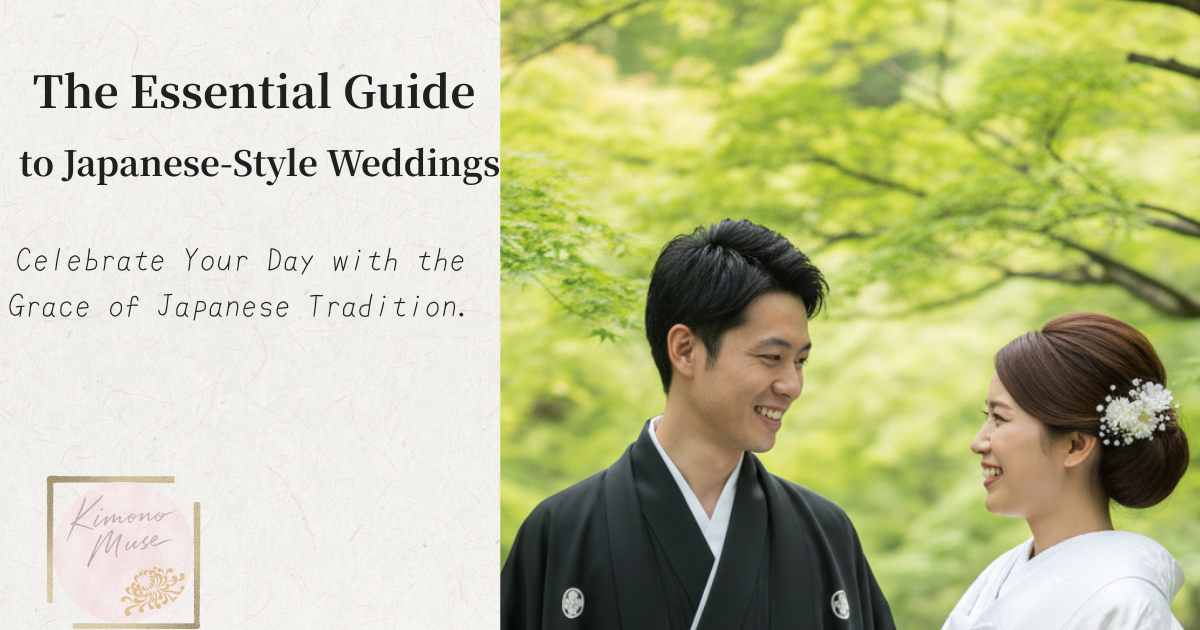The Essence of a Japanese Wedding – Where Tradition Meets Modern Beauty
A Japanese-style wedding (washō-kon) is a special celebration that blends Japan’s timeless sense of beauty with the sensibilities of the modern era.
Traditional bridal kimono such as the shiromuku (pure white wedding kimono) and iro-uchikake (colorful over-robe) carry deep symbolic meanings — purity, dignity, and grace. Simply wearing them brings a poised, elegant feeling that straightens one’s posture and spirit.
In recent years, more couples have embraced “wa-modern” styles — blending tradition with personal expression. Ceremonies held at photogenic shrines or Japanese gardens have become especially popular, offering both serenity and beauty.
A Japanese wedding in kimono is once again being cherished by many brides as a way to honor family bonds while also expressing individuality.
In this guide, we’ll help you prepare for a wedding you’ll look back on and say, “I’m so glad I chose a traditional kimono.”
We’ll cover everything — costs, preparation steps, and how to choose your perfect kimono — so you can fully enjoy this once-in-a-lifetime experience as a Japanese bride.
- What Is a Japanese-Style Wedding? — Its Beauty and Traditions
- Estimated Costs of a Japanese-Style Wedding and How to Plan Your Budget Wisely
- Your Wedding Preparation Roadmap — When and How to Start
- Avoid Regrets — Key Things to Know Before Your Japanese-Style Wedding
- Conclusion: How to Create the Perfect Japanese-Style Wedding
What Is a Japanese-Style Wedding? — Its Beauty and Traditions
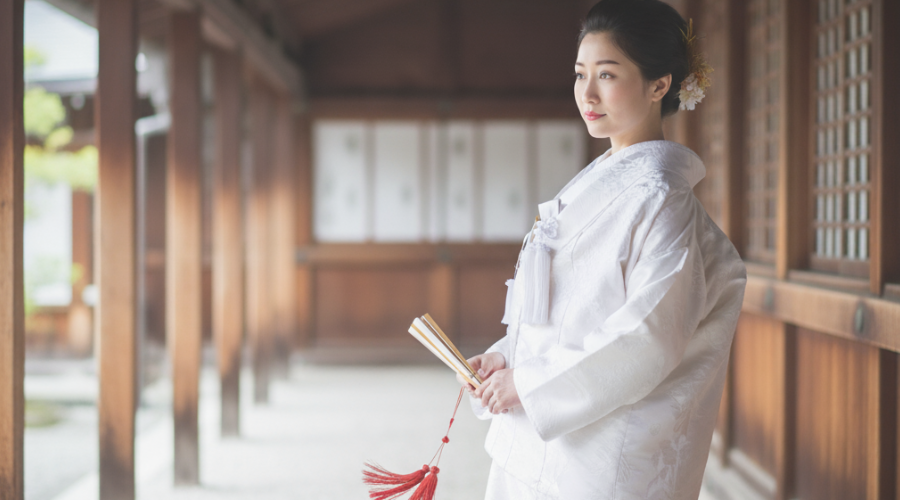
A wa-kon, or Japanese-style wedding, is a ceremony that celebrates Japan’s traditional beauty through the bride’s attire — such as the shiromuku (pure white kimono) or iro-uchikake (colorful over-robe) — and a serene, elegant atmosphere inspired by Japanese culture.
Many people imagine that a wa-kon must be extremely formal and full of strict rules.
In reality, there’s no single “right” way to hold a Japanese-style wedding.
While some couples choose a Shinto ceremony (shinzen-shiki) to make their vows at a shrine, others prefer a non-religious Japanese-style ceremony (wafuku-jinzenshiki) that feels warm and personal, shared closely with family and friends.
Today’s couples often adapt these traditions to suit their personalities — combining the beauty of heritage with modern creativity.
You might still be wondering:
“Where do I even start?”
“How do I choose the right kimono or ceremony type?”
In this section, we’ll walk you through the essential basics of Japanese-style weddings — the types of bridal kimono and ceremony formats — so that you can confidently say,
“I’m so glad I chose a traditional kimono wedding!”
Defining Traditional and Modern Styles
The style of a Japanese wedding in kimono can generally be divided into two categories:
one that emphasizes traditional formality and elegance,
and another that blends Western influences into a modern “wa-modern” style.
In this section, we’ll compare the differences between the two — especially in kimono selection and hair & makeup — to help you find a Japanese-style wedding that truly reflects who you are.
✿Three Main Types of Bridal Kimono
For a Japanese-style wedding, the bride’s kimono generally falls into three main categories.
Each carries its own meaning and creates a different atmosphere — understanding these differences makes choosing your kimono all the more enjoyable!
| Kimono Type | Features & Meaning | Main Wedding Scenes | Practical Tips & Notes |
|---|---|---|---|
| Shiromuku (All-White Bridal Kimono) | The most formal style in traditional Japanese bridal wear. The pure white color symbolizes the bride’s willingness to “be dyed in any color,” expressing purity and readiness for her new life. | Worn primarily for the ceremony (especially Shinto weddings). Creates an elegant and sacred impression. | Same level of formality as iro-uchikake. Many brides choose shiromuku for the ceremony → iro-uchikake for the reception, which saves time and dress-changing fees. |
| Iro-uchikake (Colorful Bridal Over-Kimono) | Equally formal as shiromuku. Decorated with vibrant embroidery in red, gold, and other rich colors. Known for its glamour and elegance. | Popular for reception entrance and style changes. Frequently chosen for both pre-wedding and post-ceremony photo shoots. | ⚠️ Tip: Traditionally, brides do not switch from iro-uchikake back to shiromuku. The common flow is shiromuku → iro-uchikake. |
| Hon-furisode / Hiki-furisode (Formal Long-Sleeved Kimono) | A long-sleeved kimono with a trailing hem. Considered slightly less formal than iro-uchikake. Easily styled with obi and accessories for a personalized look. Offers more flexibility for styling. | Suitable for a variety of scenes such as reception, pre-wedding photos, and post-wedding photos. Works well with Western-style hair and makeup. | Using a coming-of-age furisode is possible. Adding a formal obi and celebratory accessories creates an elegant bridal look. Since it’s highly formal, coordinating accessories is key to avoid looking too casual. |
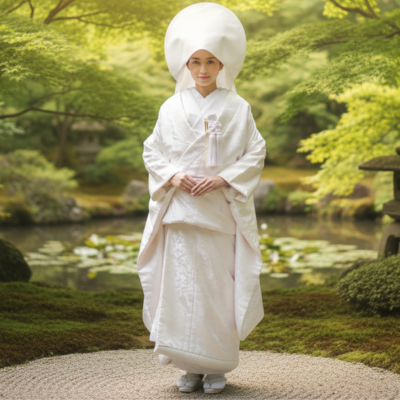
A pure white kimono symbolizing purity and new beginnings — traditionally worn for Shinto wedding ceremonies.
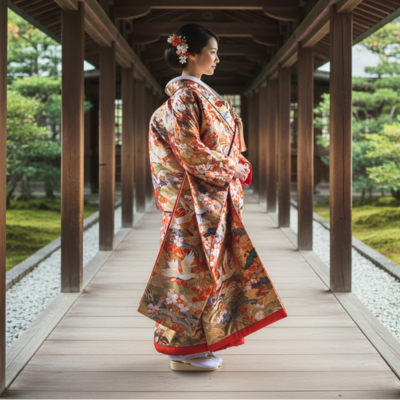
A vibrant, richly embroidered over-robe often in red or gold hues, representing celebration and joy. Commonly worn for the wedding reception or photo sessions.
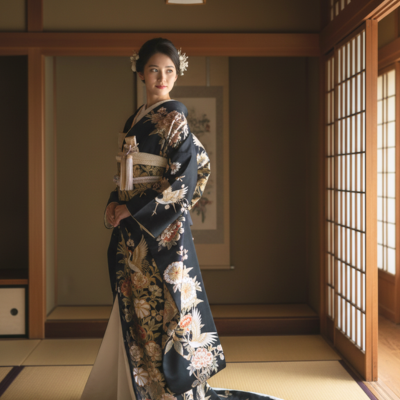
A long-sleeved kimono with a trailing hem, offering both elegance and modern versatility — perfect for receptions and photo shoots.
✿Traditional Style
The traditional bridal style cherishes Japan’s classic image of the bride, emphasizing formality and serene elegance that have been passed down through generations.
| Element | Features | Tips for Brides |
|---|---|---|
| Attire | Wearing formal bridal kimono such as shiromuku (the most formal), iro-uchikake, or black hikifurisode. | As a once-in-a-lifetime experience, you can embrace the most traditional and iconic style of a Japanese bride. |
| Hair & Makeup | Traditional styles such as bunkin takashimada (formal wig style), tsunokakushi headpiece, and wataboshi hood. | If you wish to fully honor the elegance and dignity of traditional bridal style, this classic combination is unmatched. |

A classic Japanese bridal hairstyle symbolizing elegance and dignity. Traditionally worn with kanzashi ornaments for a refined look.
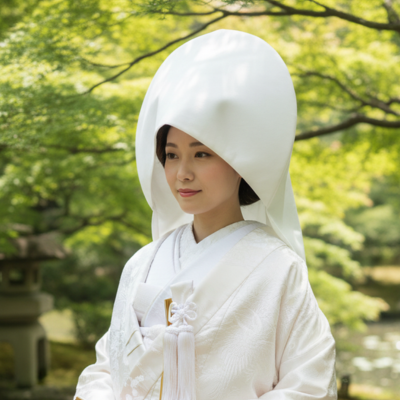
A soft white silk hood worn over the wig during a Shinto wedding ceremony — representing purity and the bride’s new beginning.
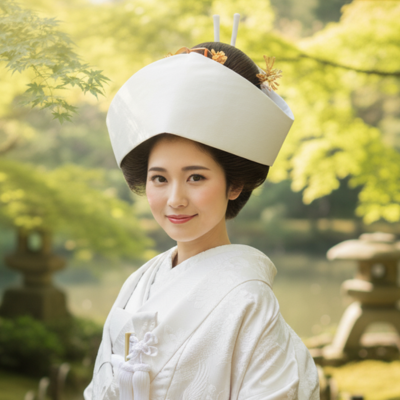
A traditional headdress worn over the hairstyle, said to “hide the horns” of jealousy, expressing the bride’s gentle heart and readiness for marriage.
✿Modern “Wa-Modern” Style
The modern Japanese-style (wa-modern) approach keeps the elegance of traditional bridal attire while incorporating elements of contemporary fashion and Western trends.
It’s especially popular among couples who want to express their own individuality within a traditional framework.
| Element | Features | Tips for Brides |
|---|---|---|
| Attire | Traditional bridal kimono styled with modern accent colors and accessories, or choosing a hikifurisode that is elegant yet easy to move in. | Even with traditional kimono, you can add personality with stylish obi accessories or a Western-style bouquet. |
| Hair & Makeup | Flexible styling such as Western-style hair, fresh flowers, kanzashi hair ornaments, or mizuhiki cords. | Hairstyles can be done in a Western style, which is reassuring for brides who feel unsure about wearing a traditional wig. |
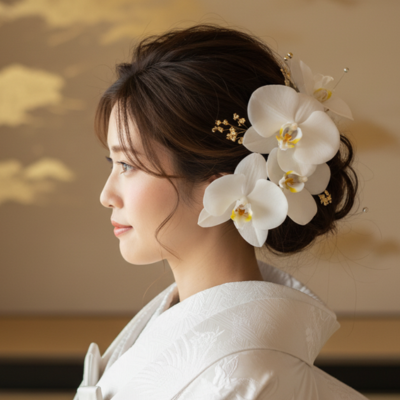
A modern bridal hairstyle adorned with white phalaenopsis orchids — a symbol of elegance and purity, perfect for a contemporary Japanese look.
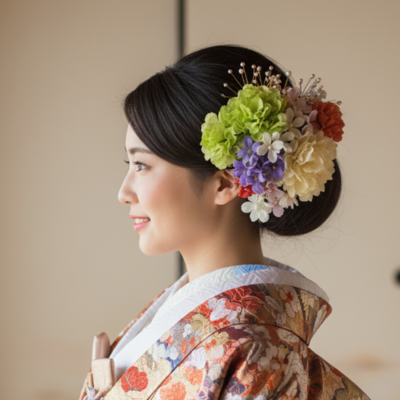
A colorful and romantic style using fresh flowers that reflect the beauty of the seasons, adding warmth and vibrance to traditional attire.
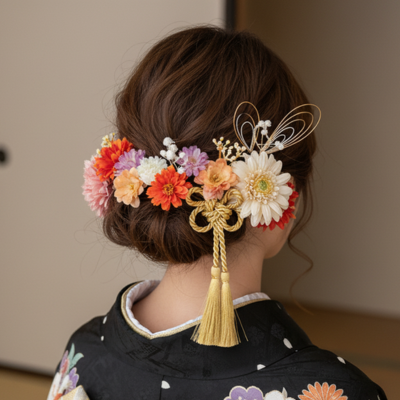
A creative fusion of modern and traditional — combining gold mizuhiki cords and chrysanthemums for a stylish, distinctly Japanese accent.
Popular Types of Japanese Wedding Ceremonies
Shinto Wedding Ceremony (Shinzen-shiki) — Rituals and Meanings
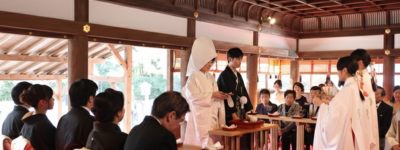
A Shinto wedding ceremony (shinzen-shiki) is a solemn and deeply symbolic ritual in which the couple makes their vows before the kami — the Shinto deities — and unites not only as two individuals but also as two families.
Held at a shrine or Shinto altar, this traditional ceremony embodies purity, harmony, and gratitude.
Let’s take a closer look at the beautiful sequence of this moving ritual.
| Ceremony Step | Reading (Romaji) | Meaning & Description |
|---|---|---|
| Entrance (Sanshin-no-gi) | さんしんのぎ | The couple and their families proceed solemnly to the shrine, led by the Shinto priest (saishu). This “bridal procession” moves gracefully to the sound of traditional gagaku court music. |
| Purification Rite (Shubatsu-no-gi) | しゅばつのぎ | The priest performs a purification ritual at the beginning of the ceremony to cleanse the body and mind of all participants. |
| Norito Recital (Norito-sōjō) | のりとそうじょう | The priest offers a norito prayer to the kami, reporting the marriage and asking for divine blessings and everlasting happiness. |
| San-san-kudo (Three Sake Cups Ritual) | さんこんのぎ / さんさんくど | Known as “Three Times Three,” the bride and groom exchange sake cups to symbolize their eternal bond and their vows before the gods. |
| Reading of the Vows (Seishi-sōjō) | せいしそうじょう | The couple read their written vows aloud before the kami. The groom typically reads the full text, while the bride reads her name and final affirmation. |
| Offering the Sacred Branch (Tamagushi-hōten) | たまぐしほうてん | The couple offer a tamagushi, a sacred sakaki branch, to the deities as a sign of respect and gratitude, connecting their hearts with the divine. |
| Exchange of Rings (Yubiwa-kōkan) | ゆびわこうかん | Originally a Western custom, ring exchange is now often included in Shinto ceremonies as a modern symbol of eternal love. |
| Family Unity Cup (Shinzoku-hai-no-gi) | しんぞくはいのぎ | Both families share sacred sake together, signifying the union of the two households and welcoming each other as relatives. |
| Recession (Taijō) | たいじょう | The ceremony concludes as the newly married couple leave the shrine together with their guests, expressing gratitude and joy. |
The Flow and Meaning of a Buddhist Wedding Ceremony (Butsuzenshiki)

A Buddhist wedding ceremony (butsuzenshiki) is a solemn ritual in which the couple expresses gratitude for the enishi — the sacred bond that connects them — before the Buddha (honzon, the principal object of worship) and their ancestors.
Unlike a Shinto ceremony, it carries a gentler, spiritual warmth that touches the heart.
| Ceremony Step | Reading (Romaji) | Meaning & Description |
|---|---|---|
| Entrance (Nyūdō) | にゅうどう | Guided by a Buddhist priest, the couple and their guests enter the main hall where the ceremony will take place. |
| Reading of the Declaration (Keibyaku-mon Rōdoku) | けいびゃくもんろうどく | The officiating priest reads a declaration to the Buddha and the ancestors, reporting that the couple have been united through sacred enishi (bond). |
| Offering of Prayer Beads (Nenju Juyo) | ねんじゅじゅよ | The priest presents nenju (Buddhist prayer beads) to the bride and groom. These beads symbolize their spiritual bond with the Buddha and serve as a charm for their shared life together. |
| Exchange of Rings (Yubiwa Kōkan) | ゆびわこうかん | Although not a traditional Buddhist practice, many modern ceremonies include an exchange of rings as a contemporary symbol of love and commitment. |
| Words on Marriage (Shikon-no-ji) | しこんのじ | The priest delivers a sermon based on Buddhist teachings, offering guidance on mutual respect and the path the couple should follow as partners. |
| Incense Offering (Shōkō) | しょうこう | The couple offers incense to the Buddha and their ancestors, expressing gratitude and reverence through this quiet, meditative act. |
| Vow Cups (Seihai) | せいはい | The couple exchange ceremonial sake cups to seal their vows, similar to the san-san-kudo ritual in Shinto weddings. |
| Toast (Kanpai) | かんぱい | A celebratory toast shared with family members, usually during the post-ceremony meal, to honor the couple’s new beginning. |
| Congratulatory Messages (Shukuji) | しゅくじ | Family representatives and guests offer words of congratulations and blessings to the newlyweds. |
| Recession (Taidō) | たいどう | Following the priest, the couple and their guests exit the main hall, concluding the ceremony with gratitude. |
Japanese-Style Non-Religious Wedding Ceremony (Wasō Jinzenshiki) — Flow and Meaning
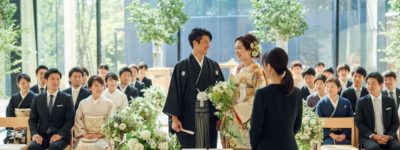
A jinzenshiki, or non-religious wedding ceremony, is a style in which the couple makes their vows not before gods, but before all of their guests, who serve as witnesses to their union.
Because there are no strict rules or religious requirements, couples are free to design a truly original celebration — often blending traditional Japanese elements with modern, personal touches.
| Ceremony Step | Meaning & Description |
|---|---|
| Entrance of the Couple | The bride and groom enter the venue to warm applause from their guests. Many couples add emotional touches such as a bouquet ceremony, or a lip rouge ritual where the bride’s mother applies the final touch of lipstick — symbolizing her blessing. |
| Introduction of the Couple | The host or officiant introduces the couple’s story — how they met, their journey together, and personal anecdotes — creating a relaxed and joyful atmosphere. |
| Exchange of Vows | The couple read aloud their own original vows, written in their own words. This is often the most personal and expressive moment, sometimes including humor or heartfelt promises. |
| Signing the Marriage Certificate | The bride and groom sign a marriage certificate or Japanese-style wedding certificate. Some couples invite their parents or guests to sign as witnesses, symbolizing shared blessings. |
| Exchange of Rings | The couple exchange rings as a symbol of eternal love. Some include a ring relay using braided cords (kumihimo) or a Japanese-style ring pillow, inviting guests to take part. |
| Declaration of Marriage | The host or a representative guest formally declares the marriage complete, followed by applause from all attendees — affirming the couple’s union. |
| Toast | (Sometimes done before the recessional) A toast with champagne or sake celebrates the couple’s happiness with all guests — a reflection of the warm and flexible nature of the jinzenshiki ceremony. |
| Recession | The newlyweds walk out surrounded by applause. Some add festive Japanese touches such as a crane origami shower or ribbon toss for a joyful and memorable finale. |
Estimated Costs of a Japanese-Style Wedding and How to Plan Your Budget Wisely

It’s perfectly natural to wonder, “Isn’t a Japanese-style wedding expensive?”
The truth is — while it can seem costly at first glance, a closer look shows that with a bit of creativity and smart planning, you can achieve your ideal ceremony without overspending.
Let’s start by getting a simple overview of the typical costs involved in a Japanese-style wedding.
Typical Costs for a Japanese-Style Wedding
For a Japanese-style wedding, the total cost typically ranges from 2 to 4 million yen (approximately USD 13,000 – 26,000), though this varies greatly depending on the scale of the reception.
Let’s take a closer look at the main expenses that make up most of the budget.
| Category | Average Cost Range | Key Points |
|---|---|---|
| Bridal Attire | Approx. ¥150,000–¥450,000 | Rental fees for shiromuku or iro-uchikake tend to range ¥100,000–¥300,000, and bridal accessories/inner layers around ¥50,000–¥150,000. Costs vary widely depending on fabric quality and brand. |
| Ceremony Fee | Approx. ¥100,000–¥300,000 | For a Shinto ceremony at a shrine, costs may include venue use and appreciation fees for the priests. Details differ depending on location. |
| Reception & Catering | From ¥1,000,000 and up | Includes food, drinks, and venue decoration. This is the most variable cost, usually proportional to the number of guests. |
| Photography & Videography | Approx. ¥100,000–¥200,000 | Studio or on-location shooting, plus pre-wedding or same-day sessions. Additional options will increase the cost. |
| Other Expenses | Approx. ¥500,000–¥1,000,000 | Items such as floral arrangements, wedding favors, paper items, entertainment, and transportation. |
💡 Note:
Prices can vary widely depending on region, season, and whether items are rented or custom-made.
Careful budgeting and early consultation with vendors can help balance tradition and personal style beautifully.
Smart Ways to Save on a Japanese-Style Wedding — Without Regret
You don’t have to give up your dream wedding to stay within budget.
With a few thoughtful choices and creative ideas, you can plan a beautiful ceremony that’s both meaningful and affordable.
The key is to set a realistic budget and spend wisely on what truly matters to you.
1. Consider Renting or Bringing Your Own Kimono
- Choose rental instead of purchase:
Purchasing a shiromuku or iro-uchikake can be very expensive and difficult to store afterward. Renting is a smart, budget-friendly alternative. - Compare multiple rental shops:
Visiting several stores or reusing your furisode from your Coming-of-Age ceremony can significantly reduce your costs.
2. Rethink the Scale and Timing of Your Ceremony
- Adjust the size of your event:
Opting for a smaller, intimate gathering or a simple shinzen-shiki (Shinto ceremony) or jinzenshiki (non-religious ceremony) can lower expenses on venue and catering. - Choose off-peak dates:
Holding your wedding outside the busy spring and autumn seasons—or on a weekday—often comes with venue discounts and special offers.
3. Save with Creativity and Cooperation
- DIY decorations and small items:
Making part of the floral arrangements yourself or preparing practical, locally sourced gifts for guests can help you save money while adding a personal touch. - Ask for help from friends and family:
Involving loved ones in decorations or reception duties not only reduces costs but also brings a warm sense of community to your special day.
Plan within your means, and create a day that reflects both of you—beautifully and authentically.
Your Wedding Preparation Roadmap — When and How to Start

When planning a Japanese-style wedding, two moments are especially important:
deciding on your venue and kimono early, and finalizing your beauty preparations at the right time.
By understanding the overall timeline in advance, you can stay organized and enjoy the process without regrets.
| Timing | Key Actions | Important Points for Kimono Weddings |
|---|---|---|
| Top Priority | ||
| 1 year – 10 months before | Research and decide on venue & bridal kimono | Shrine reservations and popular shiromuku / iro-uchikake styles book up quickly. Decide on the ceremony style and number of guests first—these two factors shape everything else. |
| Mid-Stage | ||
| 8 – 4 months before | Finalize guest list, invitations, and details | Hold the two-family meeting (formal tradition), send invitations, and select meals and gift items. Consider Japanese-style décor and accessories to match the bridal look. |
| Final Prep | ||
| 2 months before – Wedding day | Final confirmations & beauty preparation | Schedule hair and makeup rehearsals (including wig options, if using). Final checks for bridal kimono accessories and hakama accessories to avoid missing items. |
Beauty Preparation Schedule for the Perfect Japanese Bride
| Action | Suggested Timing | Key Points for Kimono Weddings |
|---|---|---|
| Bridal beauty treatments (esthetic care) | Ideally start at least 3 months before | Slimming treatments and deep skin improvement take time, so beginning 3 months ahead ensures the best results. |
| Custom nail tips (press-on nails) | 1 month before | Decide on the design early and have them made in advance to avoid last-minute stress. |
| Hair & makeup trial | 2 months – 3 weeks before | Finalize choices for wig or Western-style hair. Decide on hair length and color at this stage as well. |
| Pre-wedding or post-wedding photo shoot | 1 month before | Great for checking your full styling. Trying the same kimono and hair & makeup as the wedding day helps identify any adjustments needed. |
| Shaving (face, neck, back) | 3–7 days before | ⚠️ Avoid shaving the day before or on the wedding day; the skin needs time to recover. The nape, back, and face are essential areas for kimono weddings. |
| Nails, hand & foot care | Day before | Finish nail styling and hand/foot care, then get a good night’s rest to stay in the best condition for the big day. |
💡 Tip:
For a flawless kimono appearance, balance professional care with gentle self-maintenance.
Japanese bridal beauty emphasizes purity, refinement, and natural radiance — qualities that shine through mindful preparation.
Avoid Regrets — Key Things to Know Before Your Japanese-Style Wedding
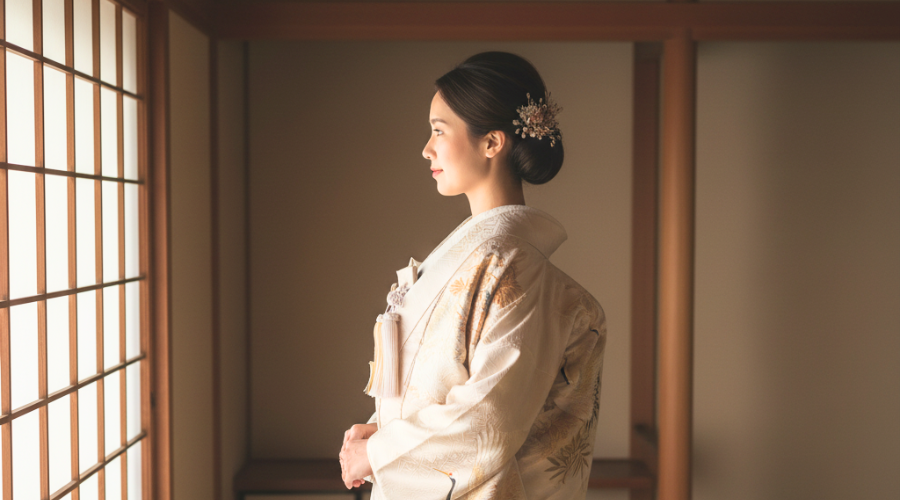
A Japanese-style wedding is truly special — elegant, meaningful, and filled with tradition.
But because it differs from Western-style ceremonies, there are a few important things to know in advance and some unexpected details that can catch you off guard.
Don’t worry — once you understand the key points, you’ll be ready to enjoy every moment with confidence.
Let’s go through some real examples of “I wish I’d known that earlier!” moments, and learn how to avoid common pitfalls so your preparation will be filled with excitement, not stress.
Important Details Often Overlooked When Preparing for a Japanese-Style Wedding
| Potential Issue | Cause & Solution | Example Advice |
|---|---|---|
| Physical Comfort | ||
| Felt tight and uncomfortable throughout the ceremony due to kimono layers and firm tying | Shiromuku and iro-uchikake are heavy, and multiple layers make movement difficult. The obi (sash) can feel tighter than expected. | Prioritize good sleep and nutrition before the wedding. During dressing, if anything feels too tight, communicate gently and clearly to the dresser so adjustments can be made without strain. |
| Attire Availability | ||
| Could not wear the kimono I wanted because reservations were full | Popular kimono and new designs book quickly — often right after choosing the venue (about a year before). | Begin choosing your kimono as soon as the venue is decided. Book fittings early to secure popular iro-uchikake or new designs. |
| Weather | ||
| Planned outdoor bridal procession (san-san-ku or shrine procession) was cancelled due to rain | Shrine wedding processions are held outdoors, so weather disruptions are unavoidable. | Confirm backup indoor plans in advance. If the venue has covered walkways or indoor photo spots, it ensures your experience remains beautiful even in bad weather. |
💡 Tip:
Even the most traditional Japanese weddings require flexibility. Communicating with your stylists, photographers, and coordinators early ensures that unexpected moments become part of your beautiful story — not your regrets.
Conclusion: How to Create the Perfect Japanese-Style Wedding
In this article, we’ve explored everything you need to know to make your Japanese-style wedding one that truly makes you say, “I’m so glad we chose traditional attire.”
From estimated costs and the preparation process to practical tips for avoiding regrets, each section was designed to help you plan with confidence.
The true charm of a Japanese-style wedding lies not only in the elegance of the shiromuku and iro-uchikake, but also in how it allows you to rediscover the beauty of tradition and the bond between families.
Today’s Japanese weddings beautifully blend timeless tradition with modern individuality, allowing you to create a celebration that feels both authentic and uniquely yours.
So, keep this “Essential Guide to Japanese-Style Weddings” by your side, turn your worries into confidence, and enjoy every moment of becoming a Japanese bride — radiant and true to yourself.
